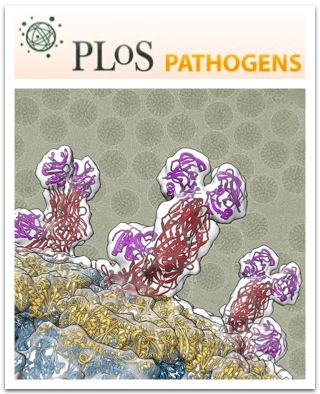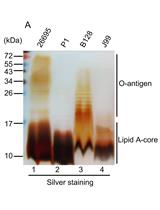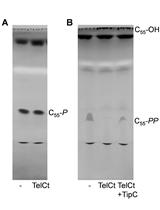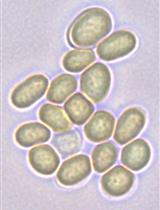- EN - English
- CN - 中文
Extraction and Purification of Mycobacterial Mycolic Acids
分枝杆菌霉菌酸的提取和纯化
发布: 2014年10月20日第4卷第20期 DOI: 10.21769/BioProtoc.1265 浏览次数: 14257
评审: Fanglian HeElizabeth Libby
Abstract
Mycolic acids are major long-chain fatty acids, containing up to 80-90 carbon atoms that represent essential components of the mycobacterial cell wall (Pawelczyk and Kremer, 2014). Each mycobacterial species possesses a specific mycolic acid profile characterized by various chemical modifications that decorate the lipid. Mycolic acids play a critical role in the architecture and impermeability of the cell envelope, hence the natural resistance of mycobacteria to most antibiotic treatments. They are also key determinants of virulence in pathogenic species, including Mycobacterium tuberculosis (M. tuberculosis), the causative agent of tuberculosis. In addition, they are known as the primary target of several first-line and second-line antitubercular drugs. Thus, the unique enzymes involved in the mycolic acid biosynthetic pathway represent an attractive reservoir of targets for future chemotherapy whose developments are particularly warranted in the context of multi-drug-resistant and extensively-drug-resistant strains of M. tuberculosis. Herein, we describe a protocol to extract the mycolic acids from mycobacteria. Purification of the various subspecies may be particularly useful for subsequent structural studies involving mass spectrometry or NMR. The qualitative and quantitative biochemical characterization of the mycolic acid pattern by thin layer chromatography can be used to address how drugs alter mycolic acid biosynthesis (Alahari et al., 2007, Hartkoorn et al., 2012), to study the phenotypes of genetically modified mutants affected in this metabolic pathway (Bhatt et al., 2007) or to unravel new mycolic acid regulatory mechanisms (Vilcheze et al., 2014). The same protocol can be applied to all mycobacteria, including environmental and pathogenic species.
Keywords: Mycobacterium (结核分枝杆菌)Background
Materials and Reagents
- Mycobacterial cultures including Mycobacterium tuberculosis, BCG, M. smegmatis and M. abscessus but can be extended to any other species.
- Tyloxapol (C17H30O4) (Sigma-Aldrich, catalog number: T8761 )
- Glycerol (C3H8O3, 99.5%) (Euromedex, catalog number: 50405 )
- Potassium diphosphate (K2HPO4) (Merck KGaA, catalog number: 1.05104 )
- L-asparagine monohydrate (C4H10N2O4, ≥99%) (Sigma-Aldrich, catalog number: A8381 )
- Citric acid (C6H8O7, 99%) (Sigma-Aldrich, catalog number: C0759 )
- Ferric ammonium citrate (C7H13FeNO7) (Sigma-Aldrich, catalog number: F5879 )
- Zinc sulfate heptahydrate (ZnSO4.7H2O, ≥99%) (Sigma-Aldrich, catalog number: Z4750 )
- Magnesium sulfate (MgSO4) (Sigma-Aldrich, catalog number: M7506 )
- Tetrabutyl ammonium hydroxyde (TBAH) (C16H37NO, 40% solution) (Sigma-Aldrich, catalog number: 178780 )
- Dichloromethane (CH2Cl2, ≥99.8%) (Carlo Erba, catalog number: 412622000 )
- Iodomethane (CH3I, 99%) (Sigma-Aldrich, catalog number: I850-7 )
- Diethylether (CH3CH2OCH2CH3, 99.5%) (Carlo Erba, catalog number: 447521 )
- Hexane [CH3(CH2)4CH3, pure isomeric mixture] (Carlo Erba, catalog number: 339852 )
- Ethyl acetate (CH3COOC2H5, 99.9%) (Carlo Erba, catalog number: 448251 )
- Molybdophosphoric acid hydrate (H5Mo12O41P) (Sigma-Aldrich, catalog number P7390 )
- Rhodamine 6G (C28H31ClN2O3, Dye content ~95 %) (Sigma-Aldrich, catalog number R4127 )
- Middlebrook 7H9 broth (Difco, catalog number: 271310 )
- Sauton’s media (see Recipes)
Equipment
- Aluminium Silica gel TLC plates 60F254 (Merck KGaA, catalog number: 1.05554.0001 )
- Plastic Silica gel TLC plates 60F254 (Merck KGaA, catalog number: 1.05735.0001 )
- Round-bottom borosilicate glass tubes (Corning, catalog number: 99449-16 ) with phenolic screw caps (Corning, catalog number: 9998-15 )
- 10 µl capillary tubes Ringcaps (Dutscher Scientific, catalog number: 0 90512 )
- Spectrophotometer
- 75 cm2 tissue culture flasks (Sarstedt, catalog number: 83.1813 )
- 37 °C incubator or 30 °C incubator for growing mycobacteria such as M. marinum
Notes: Atypical mycobacteria and BCG should be handled according to institutional standards of practice for biosafety whereas M. tuberculosis cultures should be handled in biosafety level 3 facility.
- 50 ml conical Corning CentriStart tubes (Corning, catalog number: 430828 )
- 15 ml conical Corning CentriStart tubes (Corning, catalog number: 430790 )
- Centrifuge with swinging bucket rotor for spinning down bacterial cultures (for example, Prolabo, model: HR340 with the 15 ml and 50 ml adaptors)
- pH meter
- Ultrasonic waterbath (Bandelin Sonorex, model: RK102H )
- Stuart Rotator SB3
- Stuart block heater (Stuart, model: SBH200D )
- TLC developing tank
- Zymark TurboVap evaporator (Biotage, catalog number: C133718 )
- Handheld UV lamp VL-6-LC 365 nm/254 nm
- 1800W Heat gun (Power Performance, model: PHG1800T2 )
- Reagent Sprayer, all glass, with 100 ml Erlenmeyer flask (CAMAG, catalog number: 022.6100 )
- TLC Spray Cabinet (CAMAG, catalog number: 0 22.623 0)
Procedure
文章信息
版权信息
© 2014 The Authors; exclusive licensee Bio-protocol LLC.
如何引用
Readers should cite both the Bio-protocol article and the original research article where this protocol was used:
- Dupont, C. M. and Kremer, L. (2014). Extraction and Purification of Mycobacterial Mycolic Acids . Bio-protocol 4(20): e1265. DOI: 10.21769/BioProtoc.1265.
- Alahari, A., Trivelli, X., Guérardel, Y., Dover, L. G., Besra, G. S., Sacchettini, J. C., Reynolds, R. C., Coxon, G. D. and Kremer, L. (2007). Thiacetazone, an antitubercular drug that inhibits cyclopropanation of cell wall mycolic acids in mycobacteria. PLoS One 2(12): e1343.
分类
微生物学 > 微生物生物化学 > 脂质
生物化学 > 脂质 > 脂质分离
您对这篇实验方法有问题吗?
在此处发布您的问题,我们将邀请本文作者来回答。同时,我们会将您的问题发布到Bio-protocol Exchange,以便寻求社区成员的帮助。
提问指南
+ 问题描述
写下详细的问题描述,包括所有有助于他人回答您问题的信息(例如实验过程、条件和相关图像等)。
Share
Bluesky
X
Copy link












